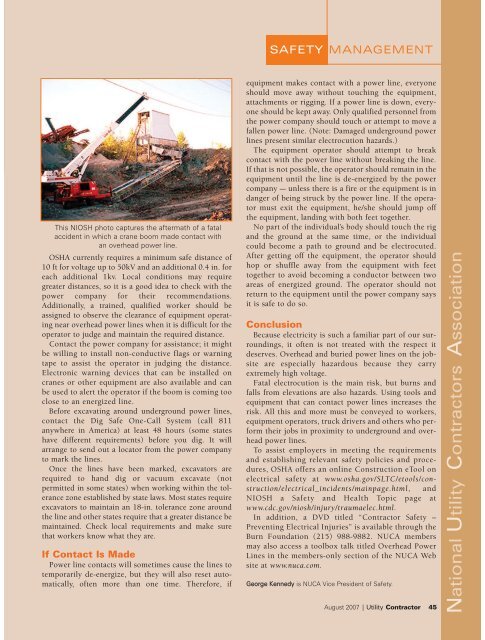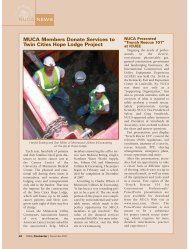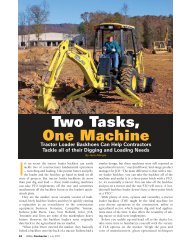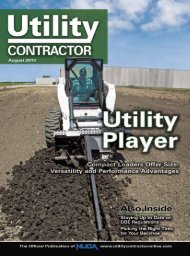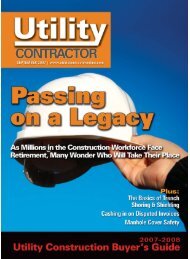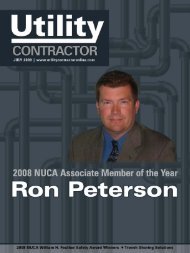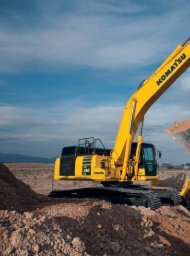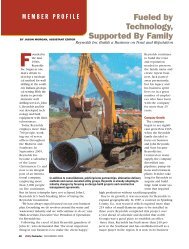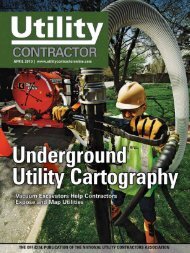View Full August PDF Issue - Utility Contractor Online
View Full August PDF Issue - Utility Contractor Online
View Full August PDF Issue - Utility Contractor Online
- No tags were found...
Create successful ePaper yourself
Turn your PDF publications into a flip-book with our unique Google optimized e-Paper software.
SAFETY MANAGEMENTThis NIOSH photo captures the aftermath of a fatalaccident in which a crane boom made contact withan overhead power line.OSHA currently requires a minimum safe distance of10 ft for voltage up to 50kV and an additional 0.4 in. foreach additional 1kv. Local conditions may requiregreater distances, so it is a good idea to check with thepower company for their recommendations.Additionally, a trained, qualified worker should beassigned to observe the clearance of equipment operatingnear overhead power lines when it is difficult for theoperator to judge and maintain the required distance.Contact the power company for assistance; it mightbe willing to install non-conductive flags or warningtape to assist the operator in judging the distance.Electronic warning devices that can be installed oncranes or other equipment are also available and canbe used to alert the operator if the boom is coming tooclose to an energized line.Before excavating around underground power lines,contact the Dig Safe One-Call System (call 811anywhere in America) at least 48 hours (some stateshave different requirements) before you dig. It willarrange to send out a locator from the power companyto mark the lines.Once the lines have been marked, excavators arerequired to hand dig or vacuum excavate (notpermitted in some states) when working within the tolerancezone established by state laws. Most states requireexcavators to maintain an 18-in. tolerance zone aroundthe line and other states require that a greater distance bemaintained. Check local requirements and make surethat workers know what they are.If Contact Is MadePower line contacts will sometimes cause the lines totemporarily de-energize, but they will also reset automatically,often more than one time. Therefore, ifequipment makes contact with a power line, everyoneshould move away without touching the equipment,attachments or rigging. If a power line is down, everyoneshould be kept away. Only qualified personnel fromthe power company should touch or attempt to move afallen power line. (Note: Damaged underground powerlines present similar electrocution hazards.)The equipment operator should attempt to breakcontact with the power line without breaking the line.If that is not possible, the operator should remain in theequipment until the line is de-energized by the powercompany — unless there is a fire or the equipment is indanger of being struck by the power line. If the operatormust exit the equipment, he/she should jump offthe equipment, landing with both feet together.No part of the individual’s body should touch the rigand the ground at the same time, or the individualcould become a path to ground and be electrocuted.After getting off the equipment, the operator shouldhop or shuffle away from the equipment with feettogether to avoid becoming a conductor between twoareas of energized ground. The operator should notreturn to the equipment until the power company saysit is safe to do so.ConclusionBecause electricity is such a familiar part of our surroundings,it often is not treated with the respect itdeserves. Overhead and buried power lines on the jobsiteare especially hazardous because they carryextremely high voltage.Fatal electrocution is the main risk, but burns andfalls from elevations are also hazards. Using tools andequipment that can contact power lines increases therisk. All this and more must be conveyed to workers,equipment operators, truck drivers and others who performtheir jobs in proximity to underground and overheadpower lines.To assist employers in meeting the requirementsand establishing relevant safety policies and procedures,OSHA offers an online Construction eTool onelectrical safety at www.osha.gov/SLTC/etools/construction/electrical_incidents/mainpage.html,andNIOSH a Safety and Health Topic page atwww.cdc.gov/niosh/injury/traumaelec.html.In addition, a DVD titled “<strong>Contractor</strong> Safety –Preventing Electrical Injuries” is available through theBurn Foundation (215) 988-9882. NUCA membersmay also access a toolbox talk titled Overhead PowerLines in the members-only section of the NUCA Website at www.nuca.com.George Kennedy is NUCA Vice President of Safety.<strong>August</strong> 2007 | <strong>Utility</strong> <strong>Contractor</strong> 45National <strong>Utility</strong> <strong>Contractor</strong>s Association


